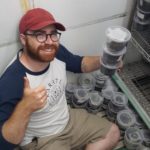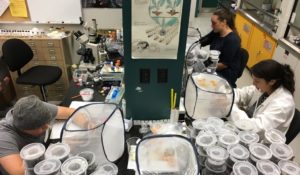This article was written by Charles-Étienne Ferland, MSc Candidate, and Dr. Rebecca Hallett, University of Guelph
A biological control agent is a beneficial insect that will help control populations of pest insects. Finding the right biological control agent is a bit like having guests over for dinner for the first time. If you’re not careful in selecting the candidate, then you might be in for a very awkward dinner. Here’s why. Introducing or encouraging the wrong biocontrol agent can cause more problems than it would solve as it could potentially kill non-target, non-pest insects, or simply not exert the desired pest control which may not be cost-effective.

Before having people over for dinner for the first time, you need to determine if it’ll be a good match with your other guests. You also need to determine if the beneficial insect you want to introduce will be the answer to your pest problem. If it’s a good fit, you may be able to reduce applications of insecticides and move towards more sustainable pest management practices. Right now, the only available tools to control swede midge are crop rotation and planting early, in addition to pesticides. How well can the small wasp Synopeas myles (our guest in this story) control the swede midge (the host) in canola fields? That’s what we, Dr. Hallett and her research team including MSc student Charles, are trying to find out.
Back to our dinner plans! What do you need to know about your dinner guests?
First, the distribution: where is this dinner party taking place? To determine the wasp’s distribution, we sampled 60 canola fields throughout Ontario over 3 years. We collected plants infested with swede midge, brought them to the lab and observed if wasps emerged from the swede midge larvae.

We then looked at seasonal abundance; when are guests likely to be available for dinner? The parasitic wasps were examined to determine the timing of the emergence of the flies. Data were recorded to get a better sense of when the guests were available over the course of the summer.
Finally, we looked at parasitism rates, what was on the menu and how much will guests eat? Here we wanted to determine the percentage of midge population parasitized by the wasp. Each wasp develops inside one swede midge larva. The parasitism rate gives us an estimate of our guests’ appetite. Ideally, voracious guests will devour all the feast their hosts have prepared. Studies have shown that biological control agents with a parasitism rate over 30-40% tend to have a good impact on their target pest, and at that level can provide some crop protection.
To summarize the current state of research: dinner is taking place in all canola growing counties of Ontario. The wasps are present between mid-June to early September, however they are most abundant at the beginning of July. The wasps are not very hungry, parasitizing only 6% of the hosts on average, and rarely reaching 30%.
By studying environmental factors, we’re hoping to figure out which field characteristics and management practices benefit the wasps and why. We’ve compared parasitism rates to factors such as soil parameters, percentage of flower cover around the field edges, and how the landscape was managed around the field. We haven’t found strong trends yet, but are continuing to investigate the effect of flowering plants and pesticide use on our guests’ abundance and parasitism rates.
In closing, biological control can be a great tool in an integrated pest management approach, particularly for the swede midge which is not easily controlled by any single tactic. Synopeas myles must be investigated further to determine which role it could play in better managing swede midge.
